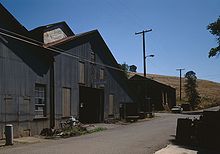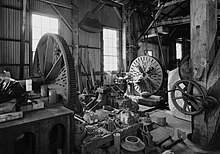Knight's Foundry and Shops
Knight's Foundry and Shops, or Knight Foundry, was a foundry for castings and a metalworking company on Eureka Street in Sutter Creek , California . The facility was built in 1873 to supply heavy equipment for gold mining and lumber processing in the Gold Country , and to enable machinery to be repaired. Samuel N. Knight developed a cast iron pulse - water turbine , which is a precursor of the Pelton turbine was. Turbine wheels of this type were installed in some of the earliest hydroelectric power plants in California, Utah, and Oregon . The facility is the last hydro-powered foundry and metalworking operation in the United States. A Knight Wheel with a diameter of 105 cm drives the main slitter, some smaller water-powered motors are used to drive other machines. The facility was entered on July 1, 1975 on the National Register of Historic Places .
history
Samuel Knight came to California from Maine in 1863 . The Knight Wheel he developed was the first water turbine in which the nozzle from which the water flowed was arranged so that the high-pressure jet hit slightly outside the center of the turbine spoon. As a result, the water energy was used more effectively. By the 1890s, the company had produced more than 300 Knight Wheels that were used throughout the western United States.
Lester Allan Pelton's competing Pelton turbine was developed in 1878 and was based on a similar principle. Instead of one, however, it used two spoons placed side by side, with the water jet directed directly between them. This proved to be more efficient in a direct comparison of the two types in 1883. The Pelton Wheel thus became the industry standard. Recognizing Pelton's superior design, Knight designed an improved electrical regulator that improved the flow of water for each type of turbine that was based on the impulse principle.
During the California Gold Rush , the foundry was one of many such operations in the area that made items needed at the time, such as mining equipment and parts for street lighting as the area prospered and cities grew. When the gold rush was over, the foundry stayed in business because it shifted to products that could not be mass- produced. Knight also developed equipment for mining, and the foundry held a total of eight patents for machines that were developed in the company, one of which was not until after Knight's death. Knight's dredger pumps were used in dredging San Francisco Bay and Puget Sound, as well as Willamette and Columbia Rivers .
Knight died in 1913, leaving ownership of the foundry to his employees. The company remained in their possession until the last of the previous employees died in 1970. The foundry was then acquired by Carl Borgh, a California aerospace engineer who was previously a customer of the company.
The foundry remained in operation until 1996 when Borgh retired and then continued to operate as a museum. The business was insufficient to cover the cost of insuring the facility. Borgh died in 1998 and the executor sold the property in 2000 to Richard and Melissa Lyman, a couple who were involved in the maintenance of old buildings. Their purchase served to ensure that the factory had an owner until the non-profit organization founded by the documentary filmmaker Andy Fahrenwald had raised sufficient funds. Fahrwald had come to Sutter Creek to make a documentary about the facility. The organization he founded failed to raise enough money, however, and eventually the town of Sutter Creek agreed to buy the property from the Lymans in 2007, although it still owns it for the nonprofit.
Work process
A model is made from hardwood by woodworkers, which is then perfected with lathes , saws and planes . All of these devices are powered by hydropower. The model is then placed in a box with a mixture of coal , bentonite clay, and pitch . This mixture then hardens to form a shape . The wooden model is then removed by dividing the shape in half. Molten iron is later poured into this mold. When the iron has solidified by cooling, the two halves of the mold are separated from each other and the finished casting can be removed.
Current status
The foundry was purchased by the town of Sutter Creek. Half of the purchase price was raised through donations and grants. Half of the purchase price was financed by guarantees and donations; nearly the full $ 1.3 million cost of redeveloping the site was raised. City and the Knight Foundry Corporation hope to complete the escrow in 2009 and begin restoration and 2010 redevelopment of the site. In addition to guided tours and exhibitions, it is planned to also offer workshops to preserve the historical craft. The project also provides for the foundry to be operated to a limited extent in order to be able to replace historical iron machine parts, lamp posts and other iron components in the appropriate style for other historical objects in the region.
The foundry is registered as California Historical Landmark # 1007 and is on the National Register of Historic Places . It has also been designated a Mechanical Engineering Historic Site by the American Society of Mechanical Engineers (ASME) and has been named one of America's Most Endangered Places by the Smithsonian Institution .
Web links
Individual evidence
- ↑ a b c Eric Bailey: Old foundry a diamond in the rough (English) , Los Angeles Times . August 8, 2007. Retrieved December 20, 2008.
- ↑ Entry in the National Register Information System . National Park Service , accessed May 24, 2016
- ↑ a b Historic Knight Foundry: A National Historic Mechanical Engineer Landmark ( English , PDF; 4.2 MB) American Society of Mechanical Engineers. February 25, 1995. Archived from the original on October 5, 2006. Info: The archive link was automatically inserted and has not yet been checked. Please check the original and archive link according to the instructions and then remove this notice. Retrieved December 20, 2008.
- ^ A b Knight Foundry and Sutter Creek ( English ) Sierra Nevada Virtual Museum. Archived from the original on July 23, 2011. Info: The archive link was inserted automatically and has not yet been checked. Please check the original and archive link according to the instructions and then remove this notice. Retrieved December 20, 2008.
- ^ Amador ( English ) California Office of Historic Preservation. Retrieved December 20, 2008.
- ↑ # 182 Knight Foundry and Machine Shop (1873) ( English ) American Society of Mechanical Engineers. Retrieved December 10, 2008.
Coordinates: 38 ° 23 ′ 36.9 ″ N , 120 ° 47 ′ 56 ″ W.

